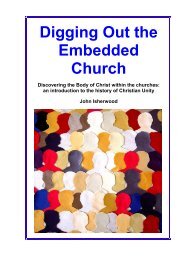Christian Unity (the book) - The Maranatha Community
Christian Unity (the book) - The Maranatha Community
Christian Unity (the book) - The Maranatha Community
Create successful ePaper yourself
Turn your PDF publications into a flip-book with our unique Google optimized e-Paper software.
• In <strong>the</strong> Eucharist, Komensky maintains that all <strong>Christian</strong>s must agreethat Jesus said ‘This is my body – blood’. <strong>The</strong> difficulty is explaining howit happens. But we are not told how, so why speculate? Komensky trieshard here to bring Catholic and Protestant toge<strong>the</strong>r here by talking ofaccepting transubstantiation in a metaphysical sense, but this does notseem to be a satisfactory solution. But isn’t Komensky’s principle infinding what is ‘agreed on’ a sound one here?• On infant baptism, Komensky believed both paedo-baptists andAnabaptists should concede that <strong>the</strong>ir position could not, withoutcontention, be argued from Scripture. Infant baptism is nei<strong>the</strong>rspecifically commanded not rejected by Scripture, so toleration of eacho<strong>the</strong>r’s position should prevail. Again, <strong>the</strong> ‘both-nei<strong>the</strong>r’ principle rules!Komensky is far too naive in his hope that <strong>the</strong> ‘both-nei<strong>the</strong>r’ principle wouldsatisfy protagonists in <strong>the</strong> 17 th Century, but perhaps he has something to sayto us in <strong>the</strong> 21 st Century.A notable contemporary of Komensky was a German, Georg Calixtus (1586-1656), whom <strong>the</strong> New International Dictionary of <strong>the</strong> <strong>Christian</strong> Church calls ‘anearly ecumenist’, and <strong>the</strong> Oxford Dictionary of <strong>the</strong> <strong>Christian</strong> Church ‘aProtestant <strong>the</strong>ologian.’He was Lu<strong>the</strong>ran Abbot of Königslutter and, from 1614, professor of <strong>the</strong>ologyat Helmstadt University. His view of what a true <strong>Christian</strong> is was remarkablylike that expressed by John Wesley in a letter to a Roman Catholic in 1749,except that Wesley did not mention baptism in his letter.Calixtus described a <strong>Christian</strong> as one who was baptised and who prays to God,Fa<strong>the</strong>r, Son and Holy Ghost. He believes Jesus was <strong>the</strong> Son of God, born of aVirgin; that he redeemed us by his sufferings and death; that he was raisedfrom <strong>the</strong> dead and will return to earth as judge of all. Such a <strong>Christian</strong> does notpersist in wickedness (Wesley would have gone fur<strong>the</strong>r on this point!).George Calixtus (his family name was <strong>the</strong> Danish ‘Kallison’) lived, as didKomensky, in <strong>the</strong> turbulence of <strong>the</strong> Thirty Years’ War, and was all his lifecaught up in religious controversy. Born in Flensburg, Schleswig-Holstein, heentered Helmstadt University as a young man and studied ma<strong>the</strong>matics,classics and philosophy. He came to see later in life that learning could becomea substitute for true faith and spirituality.Page 98








